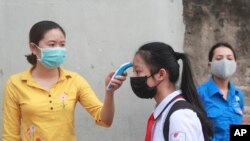Vietnam has reported few new coronavirus cases every day since mid-April. Now schools are reopening, smaller restaurants are back in business and traffic jams are forming again in the financial center, Ho Chi Minh City, as commuters head to work.
The Southeast Asian country has controlled its coronavirus caseload at just 271 across a 96 million population by quickly sealing off the border with China where the global outbreak began, quarantining tens of thousands of people and tracing the contacts of known cases.
The phased-in reopening that’s now in progress will stimulate some demand as people get back to earning money following job losses and work furloughs in April, experts in the country predict. But Vietnam’s once booming economy won’t approach pre-COVID-19 disease outbreak growth levels until at least the second half of 2020 because of a continued lack of foreign tourists and a dearth of export demand from overseas, they say.
Tourism stopped April 1 on government concerns about the risk of letting in virus-infected travelers. Vietnamese exports aren't selling as well as normal because stores overseas have closed and consumers have lost jobs due to disease containment measures.
“I would say with any luck we’ll get back to some sense of normalcy by July,” said Ralf Matthaes, founder of the Infocus Mekong Research consultancy in Ho Chi Minh City.
A return to normal would first reward retail and the manufacturing supply chain, as laborers regain jobs on the assembly lines and begin to spend their earnings. Domestic flights are powering back up too, though some hotels remain shuttered due to low demand.
A survey by Infocus found some 30% of people lost their jobs and 16% were furloughed in Ho Chi Minh City and the capital, Hanoi.
Vietnam’s economy will grow 4.8% this year, down from earlier expectations near 7%, the Asian Development Bank forecasts. On Monday Vietnamese Prime Minister Nguyen Xuan Phuc said 2020 GDP growth should be more than 5%. Private analysts estimate just 2-3%.
“Plus side, there is enough mouths and feet within Vietnam to keep things going, but that’s just within Vietnam itself, so it’s really the linkages to the rest of the world – to what extent that starts to normalize,” said Song Seng Wun, economist in the private banking unit of CIMB in Singapore.
Vietnam in this respect follows a trend among other Southeast Asian countries with controlled virus caseloads and gradual economic reopening, Song said.
But tourism has been “dead” since January, Matthaes said. In the first 11 months of 2019, by contrast, Vietnam received 16.3 million international travelers for a 15.4% increase over the same period of the previous year. Tourism made up about 8% of the economy.
Phuong Hong, 40, a travel sector worker in Ho Chi Minh City, still has her job and reports to work in an office that's quiet because of staffing rotations. On off days, she spends time at home with her eighth-grade son who will return to school next week for half days.
She expects airlines and hotels eventually to offer deals for domestic travelers but worries that Vietnamese people will face health monitoring if they travel abroad and possibly higher airfares to offset any pre-flight disease screening.
"We cannot go back to normal before the end of 2019 anymore, because you can see the restrictions on traveling," Phuong said.
Demand for Vietnam’s signature exports, such as car parts, smartphones and furniture, is expected to fall because consumers aren’t shopping. Raw materials from China have been hard to get and air cargo prices are higher than normal, business consultancy Dezan Shira & Associates says.
Exports grew just 0.5% in the first quarter of 2020 and “results will continue to be gloomy” in the current quarter, the General Department of Vietnam Customs said in an online statement.




